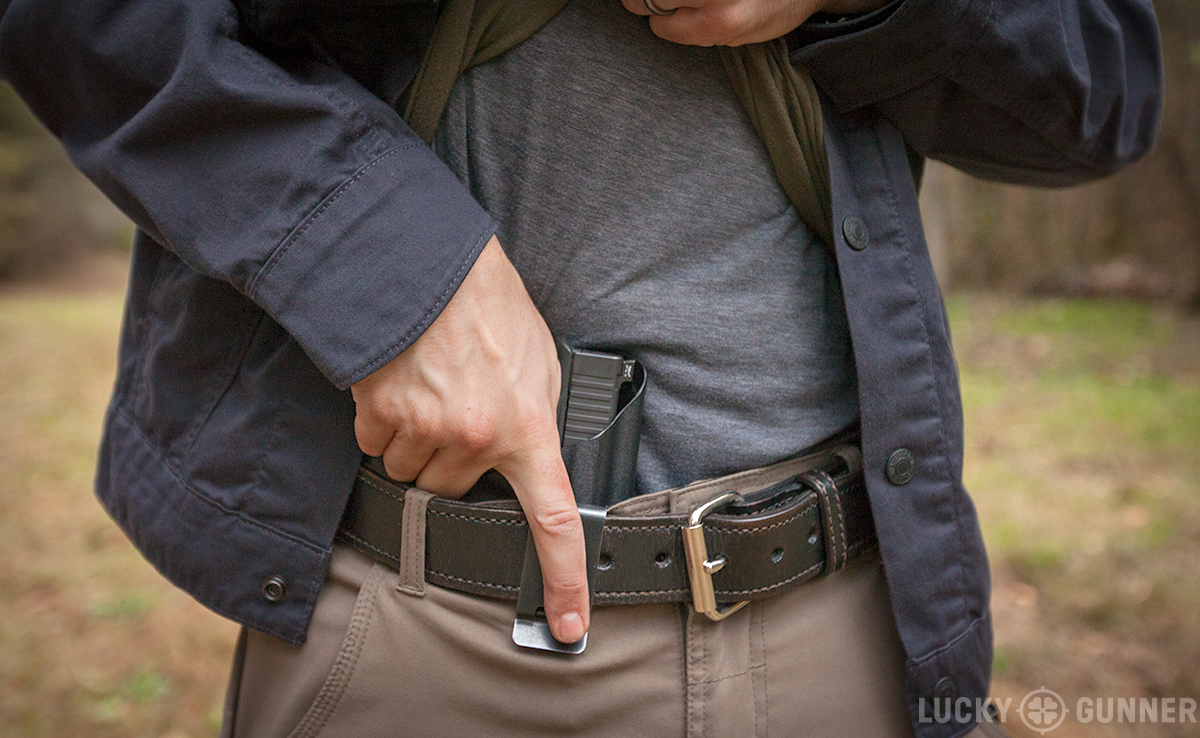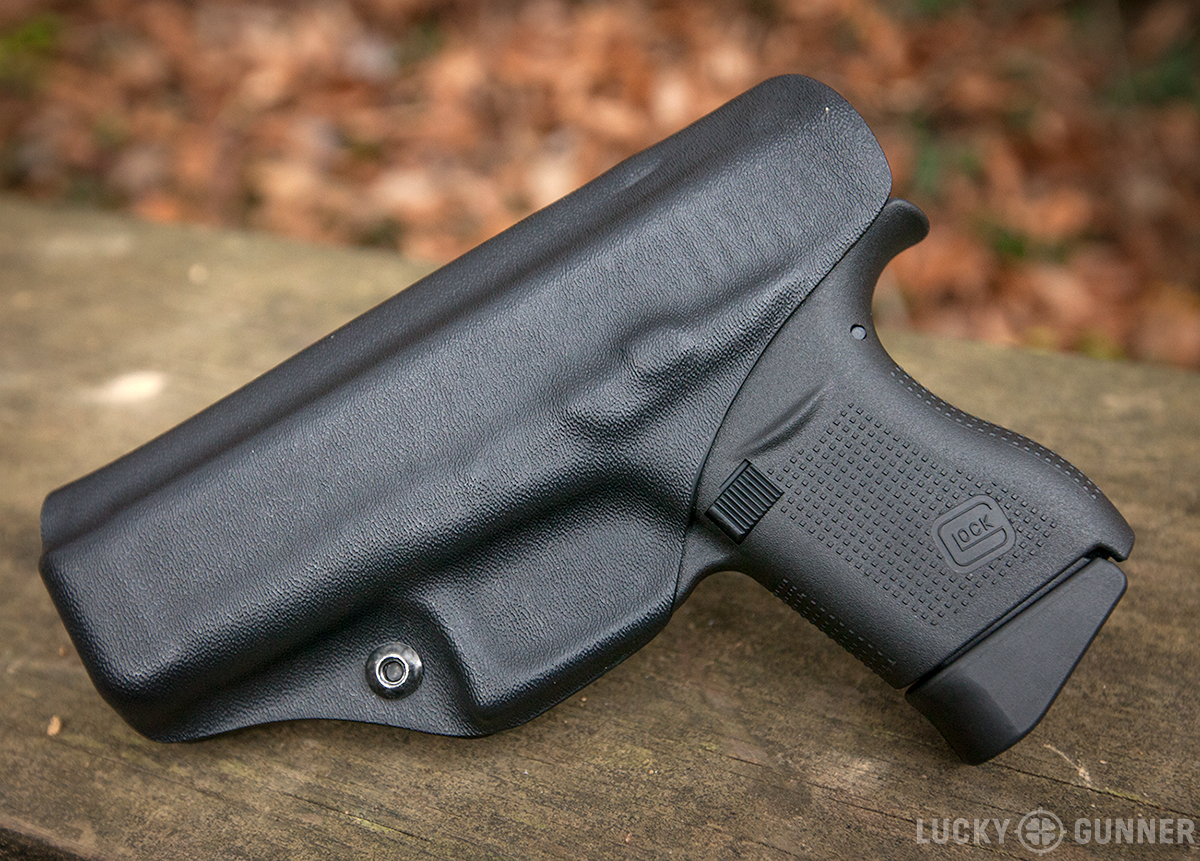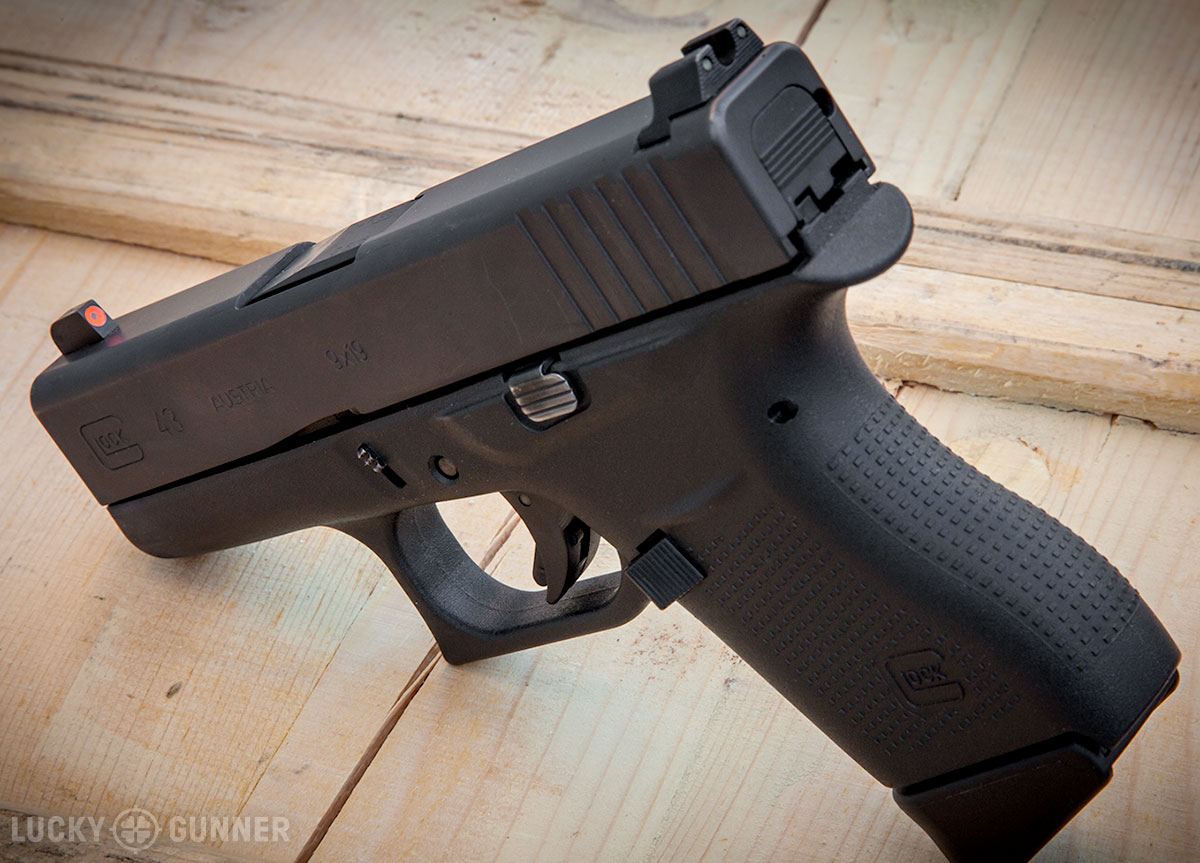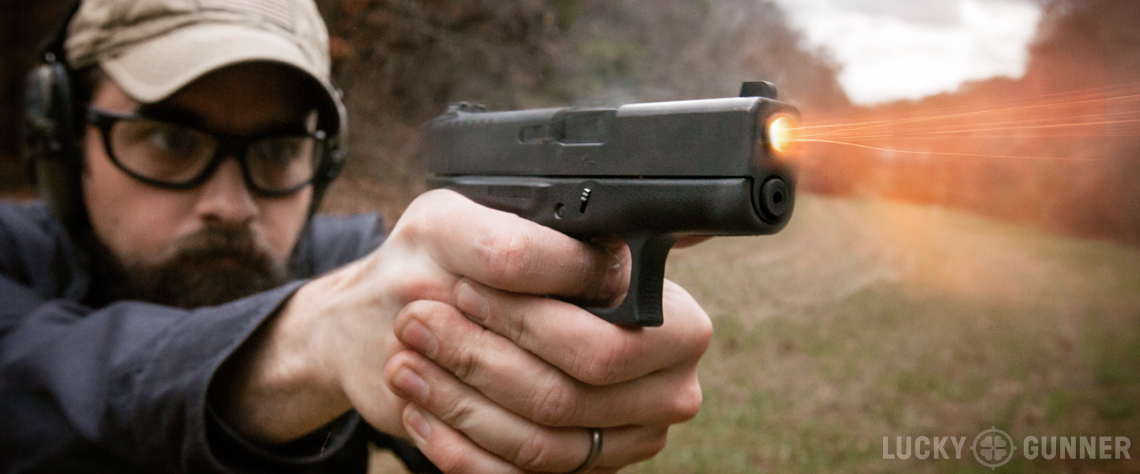There’s only one reason to carry a small gun like the Glock 43 instead of a larger and more effective pistol: convenience. We don’t carry small guns because they’re the best to have in a fight, but because they’re easier to conceal and more comfortable to carry around all day. The Glock 43 was designed with convenience in mind, but even so, is not a fashion accessory — it’s a tool made for fighting your way out of a life-threatening encounter.
Since I picked up a Glock 43 back in May, I’ve covered the run-of-the-mill technical specs and first impressions stuff, and even posted an update with more details. So far, I maintain my initial opinion that the G43 is an excellent option in the small, single stack 9mm category. It’s reliable and robust and it has well-designed ergonomics that mitigate the felt recoil and muzzle flip typically associated with pistols of this size. But now that I’m coming up on 3000 rounds through the G43, I wanted to give you guys something beyond the typical gun review-fodder and talk about a few aspects of the Glock 43 I’ve observed that relate more directly to its potential as a self-defense tool. In particular, I’ve noticed some quirks of the G43 that affect the bare essentials of self-defense shooting: getting the gun out of the holster, lining up the sights, and squeezing off multiple accurate hits to end the fight quickly.
Skin That Smoke Wagon
It’s been said, by myself and many others, that one of the most important skills you can develop with a firearm is the draw stroke. You can’t fight with a gun until it’s in your hands, so learning how to smoothly and quickly present the pistol from a holster is a critical component of self-defense. This can be challenging with the Glock 43. Small pistols that are valued for their low profile and ease of concealment naturally have less grip area to securely grab onto during the draw stroke. It’s very common for people to fumble the draw with these small guns, even during practice on a shooting range with no additional stress.
Besides consistent practice and good technique, the best way to mitigate these challenges is through careful holster selection. The first step of the draw stroke is to get a full firing grip on the gun with the dominant hand. Ideally, before you even start to remove the gun from the holster, you should have the same grip on it that you’ll have when it’s out at full extension and ready to fire. Whether you carry in a strong side belt holster or a 1 o’clock “appendix” holster, achieving a full firing grip is easy with a well designed holster, but a poorly designed holster can make it difficult, or even impossible.

The key features to look at are ride height and thumb clearance. Many holsters are designed with comfort and concealment as the primary considerations, with access being an afterthought. When the gun rides low, the grip may blend nicely into the belt line, but if there isn’t enough clearance for your fingers between the waistband and the front strap of the grip, it’ll be tough to get that full firing grip.
Thumb clearance is often hindered by a sweat guard — the raised part of the holster that provides a buffer between the body and the back of the slide. Todd Green posted a good example of this earlier this week. A sweat guard doesn’t necessarily have to be problematic, but if it prevents the web of the hand from getting as high up on the back strap as possible, a full firing grip can’t be achieved until the gun is partly lifted out of the holster.
I carry the Glock 43 in an appendix inside the waistband holster from Dark Star Gear. It has an adjustable ride height and a minimal sweat guard that keeps the rear sights from poking me in the gut but is strategically cut to allow a full firing grip. There are tons of holsters available for the Glock 43, but this is the kind of attention to detail you get when you buy a holster from someone who develops a design based on actual real world use and not comfort alone.

High Visibility
Besides the small grip, another quirk of the Glock 43 that could slow you down in a fight is the factory sights that come with the pistol. Like all other Glocks, the G43 ships with flimsy plastic sights that have a white dot painted on the front and a u-shaped white outline on the rear. Aside from their tendency to occasionally break off the slide with hard use, they really aren’t that much worse than the metal sights with three white dots that most other companies use as the default option, but that’s hardly a compliment.
Contrary to what Internet Experts might tell you, seeing the sights is an important component of fighting effectively with a handgun. It’s true that under the stress of an attack, many people panic and forget to bring the gun to eye level and line up the sights. Sometimes they manage to hit the target anyway, and sometimes they don’t. But we also have many first-hand reports of gun fight survivors who distinctly recall using their sights in the heat of the moment, and, believe it or not, these folks tend to end up with a hit percentage much higher than average. According to some research, among the factors that separate the “spray and pray” shooters from the sight users are regular practice and high visibility sights.

The major problem with the factory sights on the G43 is the lack of visibility. There’s no one-size-fits-all solution for pistol sights, but if you’re in immediate danger and have to draw that pistol, you probably want sights that are easy to see. I don’t have a strong preference for what’s on the rear sight, but I like to see an obnoxiously bright color on the front sight — something I can’t possibly miss. I’ve got Trijicon HD night sights on my Glock 43, with a bright orange ring on the front sight. There aren’t many lighting conditions in which night sights are actually all that helpful and I don’t consider them a “must-have” — the bright front sight and wide u-notch in the rear were the selling points for me. If you don’t mind the factory sights being plastic, a similar effect can be achieved by blacking out the rear sight with a marker, and some fluorescent orange paint or nail polish on the front sight. A fiber optic front sight is another high visibility and cheaper alternative to night sights. In any case, if you can only afford to make one modification to your Glock 43, I recommend upgrading the sights.
Trigger Warning
After improving the sights, many Glock 43 owners will be tempted to start tinkering with the trigger. Good trigger control is key for quick and accurate shooting, but even experienced shooters with solid fundamental skills will be slowed down by a lousy trigger.
There have been a variety of reactions to the quality of the trigger pull on the G43. This could be due to differing personal tastes or variations in manufacturing, but I suspect it’s some combination of both. The trigger on my Glock 43 weighs in at about eight pounds with the uneven “squishy” quality that all Glocks seem to have. No matter how you look at it, that’s a heavy trigger when the gun itself weighs only one pound.
But it’s not the G43’s trigger weight itself that bothers me. Regular readers of the Lounge might remember that 2015 has been the year of the revolver for me. I am no stranger to lightweight carry guns with triggers weighing 12 pounds or more. I won’t say I like that particular combination, but I have learned how to manage it fairly competently. However, even with that recent experience under my belt, the inconsistent feel of the trigger on the Glock 43 has proved to be a huge challenge for me when firing at the speed I run most other handguns, and I know I’m not alone.
The easiest solution is to take advantage of the many aftermarket trigger parts available like connectors and springs. These can slightly reduce the weight of the trigger pull and give it a smoother overall feel, leading to improved accuracy. Glock 43 trigger modifications are usually inexpensive and very simple to install, and most of them keep the weight of the trigger pull at a safe level. What’s not to like?
Well, unfortunately, sometimes improving the trigger can compromise reliability. The most common symptom is failure to fire caused by light primer strikes. The reliability of the G43 is one of its greatest strengths as a self-defense tool, but any change to the internals of the pistol has the potential to ruin that. I’m not saying you should never modify your carry pistol (although there’s a compelling case to be made for that position), but any changes should be followed by extensive test firing, both with standard FMJ ammo and with your chosen self-defense load.
You should also avoid making the trigger too light, even if reliability doesn’t suffer. Excessively light triggers can become a serious safety issue, and may also be a liability if you and your gun ever end up in court. Opinions vary on this point, but I personally wouldn’t want to carry a Glock with a trigger pull any lighter than 4.5 or 5 pounds.
Whether you modify your Glock 43 to your liking or leave it bone stock, put some serious thought into how you might have to use the gun as a life saving tool. You can try out different modifications to get the most out of it, but make these changes carefully and remember that no modification will affect your performance as much as dedicated practice. And if you choose not to change anything, keep in mind that a small pistol has inherent drawbacks in the usability department, and you might have to put in some extra range time to learn how to work around these challenges.



Much as I like Glocks (I own 3), I think I prefer my P938 Scorpion.
I want one of these BUT it is at the bottom of my wish list at the moment.
Very well written article!
I’m really interested in some day trying out the 43. I think smaller pocket pistols such as this definitely have a place in self defense. But there definitely is a problem IMO of people trying to run it just as they would a fuller sized pistol.
“Contrary to what Internet Experts might tell you, seeing the sights is
an important component of fighting effectively with a handgun.”
Well, at the risk of sounding like one of those “experts” you alluded to, here’s my opinion – and I say this as a self defense instructor with experience in combatives, knife, stick AND firearms – point shooting and the science behind those fundamentals will serve one much further in real life self defense situations. There is plenty of data to also back that up. Col. Applegate developed much of the foundational material there.
Sorry, I missed this comment earlier. The original point shooting techniques were developed at a time when pistol sights were barely visible, making the kind of speed and precision we see from today’s shooters much more difficult to achieve. Getting a rough index on the target by using the slide or barrel itself as kind of rough sight was a workaround that had merit at the time due to a lack of alternatives. Today’s pistols have bigger and more visible sights, so we don’t have the same problem that lead to the initial development of point shooting techniques.
That’s not to say that there isn’t a time and place for unsighted fire, but whether we should specifically develop our training techniques around that is debatable. Experienced shooters who are adept at quick, sighted fire at various distances typically have no trouble getting hits at close range even without the use of sights. But shooters who only train with “point shooting” programs that advocate ignoring the sights usually struggle to get good hits on targets beyond 15-20 feet.
Since 85% of all assaults with a firearm,police and civilians,occur at less than 9 feet and usually within 6 feet with a time reaction of less than 5 secs to draw and fire, the sights in real combat, not some magazine article, are worthless in survival.Your brain will focus on the threat [naturally] not the front sight and you will point and fire as fast as you can pull the trigger. Doing anything else in a real life fight will get you killed. Sights are for distance and time ,the two factors you do not have in a real gun fight at 9 feet or less.
The body’s natural response to stimuli and what one is able to achieve after dedicated training and practice are vastly different. People who ignore their sights and yank the trigger as fast as they can usually miss the target. Just because that’s what many people do when faced with the stress of a gunfight doesn’t mean that’s what we should settle for and expect to happen. The simple fact is that capable pistol shooters can and have used their sights in close range gun fights with excellent results.
training, practice and muscle memory
An instructor once taught me that, all marksmanship decisions (choice of body position, sighting, and etc.) in a fight are driven by three factors, threat, distance, and exposure. With that said, in that decision making matrix there is most definitely a place for “point shooting”. However, all the best marksmanship minds I know train to acquire their sights 100% of the time (even if it’s just the front sight post). The thought process on this is two sided. First, is the combination of
First, is the combination of instinct and a well trained natural point of a achieved under stress through muscle memory. When you combine these two factors with the extremely close distance, point shooting will happen naturally and effectively.
The second, is the principal that you will not rise to the occasion but sink to your lowest level of training. The fear here is that if point shooting is your lowest level, when the day comes that you need your sights, that you sink to point shooting out of the adrenaline and natural instinct situation
You sound like someone who doesn’t know how to point shoot. I felt the same way as you until a few years ago I took an excellent class at Sig. It is FASTER. It is a better way to fight up close. It has nothing to do with the quality of the sights.
I do agree that this skill is being taught too soon. I learned it after many years of front sight focus and I think it is a natural progression as your shooting becomes more instinctive.
In contrast, I gave a class to a rookie LEO who had just graduated a year or so before we met. Prior to going into the academy,he had never fired a gun. They immediatedly staarted him on target focused training. (point shooting) before he had a firm grasp of the fundamentals.
He was a terrible shot. In all ways, both point shooting and in sighted shooting. So over the course of 4 nights, we went back to the fundamentals of sight alignment and trigger squeeze. (90% of what it takes to shoot a pistol reasonably well) On the 4 th night I taped up his sights and had him progress to SLOW point shooting. Then I had him pick up the speed. Before he knew it he was shooting faster split times than he had ever shot before and his accuracy was much much improved. You can’t point shoot properly if your trigger squeeze is puling your gun off target. You can’t diagnose this problem if you don’t look at the front sight.
Point shooting done right is the farthest thing from “spray and pray”. It is accurate enough if done properly and much faster than sighted shooting for most people.
Don
p.s. The first defensive firearm class I ever took I had only been shooting bulls eye. After our initial string of fire, the instructor looked at my one ragged hole and told me “you need to go fster. Look at it this way, the bad guy will bleed out faster if he has more than one hole in him”. Ha. Its all a balance.
I agree. Taking my first point/instinctive/reflexive shooting class was a revelation. After shooting in bulls eye and practical shooting sports for years, I was a firm believer in the front sight mantra. By the end of 2 days at the Sig academy, I was shooting dinner plate sized groups at 20 ft and was firing as fast as I could squeeze the trigger. I was almost as accurate and fast firing with one hand pretty much as soon as the gun cleared leather. It was a revelation. I try to maintain proficiency with this skill by point shooting my actual carry gun every time I go to the range. I draw from (real) concealment and fire 3 shots of my (real) carry ammo. Then I clear the gun, and empty the mag. I put 3 or 4 new rounds in the mag first then load the old rounds on top. Lather rinse repeat.
Having owned the Glock 43 for over a month now and 500 rounds later, I love it. I am able to keep playing card size groupings at 30 feet, more than sufficient for self-defense. I traded my commander length 1911 for the Glock for EDC and feel comfortable enough with the accuracy and reliability after 500 rounds to have made the switch. if anything, it’s far more comfortable to carry!
If you’re an LEO in an Agency like NYPD you’ll be shooting a Glock 19 with a NY-2 trigger spring (12lbs), and there are other Agencies that use the NY-1 trigger spring (8lbs), so the trigger pull on the Glock 43 is not as big of an issue. And if you shoot and dry-fire a Glock, the trigger will loosen up some over time, at least that’s my experience. As you stated, practice will overcome any alleged shortcoming…
I agree — not everyone has the time or inclination to train to the level where sighted fire under stress is a possibility, and point shooting might be a decent substitute for students who will not seek additional training. Todd Green wrote a somewhat controversial article on this topic last year, and I happen to agree with most of his points: http://pistol-training.com/archives/9081
However, I assume most of my readers at least aspire to be more accomplished shooters than the guy who’s training ends with getting his CCW permit. So to the original point alluded to from the article, having a highly visible front sight is always a good thing for someone who’s working toward accuracy with speed.
Somewhere between the one-handed hip shooting that was taught to LEOs in the mid 1900s and the slow, methodical, target shooting that most folks practice at the range, there is a wide gray area that’s not clearly defined by either the terms “point shooting” or “sighted fire”. How about a quick presentation from the holster that puts the slide at eye level and a rudimentary sight picture with eyes focused on the target? Is that sighted fire or point shooting? I don’t know, but it’s quick, and doesn’t take much practice to pull off at ranges outside arm’s reach and inside 20 feet.
I ordered a Ghost 3.5lb spring, it’s too long and too thick, do ya have any ideas? I’m a 28 year Law Enforcement VETERAN. I thought about the purchase of a Drop in adjustable trigger. Can ya help me?
The biggest change in trigger FEEL in the (9) Glocks I own was achieved by polishing the connector where it contacts the sear safety button and replacing the sear safety plunger with a lighter rounded profile (mushroom style) titanium unit allowing you to equip it with a slightly lighter spring. This achieved the same smoothness of feel as the cantilever trigger i have in my 34 at a quarter the price, albeit without the over travel stop/adjustment. Most of the lousy trigger feel in glocks is caused by the engagement of the connector against the squared off sear safety plunger. Got both from glockstore.
ghost makes one for this fire arm called the ghost edge connector.
There is nothing wrong with the trigger on the model 43. The problem is with the shooter. The best trigger in the world will not fix the worst shooter in the world. Suck it up and learn to shoot.
I will start by saying that I respect ‘critics’ opinions tough some of them talk out of their A$$. I’ve been handling firearms since I was 7, USAF SP, cert. instructor since ’94. I have my own preferences and just like why we choose a specific vehicle, toilet paper or motor oil is all essentially boils down to preferences…
In the end you may/not agree with me and that’s cool, I just hate when folks get superior and hateful. That being said I respected but never really gravitated towards anything in the first 2 generations of Glock, then I spent time with a Gen 3 23 and my whole world changed. A few years ago I bought a number of Shield 9’s and got familiar by doing mods etc. The one reoccurring issue with that gun is the difficulty a lot of weaker handed shooters have with working the slide. So when the G43 came out I was excited…what a great gun! full size round, compact and every shooter I worked with women, youth, those with arthritis issues have had no issues with working the slide. Super easy to strip and maintain, Glock is definitely on to something here. I like it so much that it has become one of my go-to’s for EDC. Like many not a super huge fan of Glock factory sights, middle-aged eyes have me installing and doing well with front tritium with white outline front and blacked out rear, not always the easiest to find but if you are like me [eye sight changing…sucks!] I would recommend considering, I have been able to index targets much quicker [again]…
Good article LG Chris.
Mine is still OEM, bone stock. I like it. I’ve conducted my practice in presenting it from a holster and from my pocket from a kydex trigger guard. I can look down over the sights and put 3 to 4 out of 6 shots in a gallon milk jug from 7 yards on a fast draw. I can keep most in the label area if I take my time. This little pistol is accurate and reliable on reloads, premium ammo and the cheap Russian ammo.
I’m accustomed to firing DA on the first shot with my revolver and CZ75B. Shooting the Glock 43 is easy to transition into.
I will probably invest in tritium night sights but I’m not in a hurry to do so.
I feel secure and confidence when I am carrying concealed with it at night getting fuel, stopping at a restaurant or rest area.
“According to some research, among the factors that separate the “spray and pray” shooters from the sight users are regular practice and high visibility sights.”
Citation? All I’m finding are the commonly-cited studies done in the ’90s and ’00s saying the number of police officers who remember using their sights is very low.
i’ve been shooting Glocks since 1998. I’ve learned to manage the standard trigger just fine in a carry gun. But when I got my G42 and later G43, I had difficulties shooting it fast. The small grip combined with a trigger with significant stacking up to over 9 lbs and 8 lbs on my G42 and G43 respectively (as measured on a Lymann digital trigger gauge) combined to give me trouble. I agree that defensive Glocks should be left stock, but in this case after a fluff and buff of the stock parts, the install of a Ghost disconnector solved my problem. Each gun has over 1500 rounds through it with no light strike problems. The trigger is still in the 6.5 lb range for both guns, but the stacking is gone. Overall, this is the only mod I’d advocate with a Glock. I happen to like a white dot front sight and a black rear sight. So all I do with my Glocks is reverse the rear sight so I’m looking at the “back” of it. I also take a small file and widen the notch in the rear sight so that I have more light on each side of the front sight.
Re the dreaded plasticness of the sights, I had a G34 with over 30K rounds through it and the factory sights were fine. I’ve never broken the sights off of a Glock.
I would be interested if anyone is carrying the Glock 43 in an ankle holster?